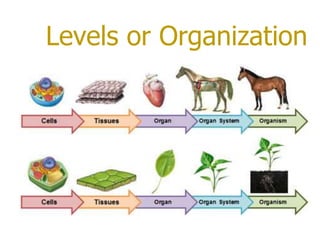Levels of Organization.pptx
•Download as PPTX, PDF•
0 likes•56 views
Life Science
Report
Share
Report
Share

Recommended
Recommended
More Related Content
Similar to Levels of Organization.pptx
Similar to Levels of Organization.pptx (20)
Recently uploaded
Recently uploaded (20)
PATNA CALL GIRLS 8617370543 LOW PRICE ESCORT SERVICE

PATNA CALL GIRLS 8617370543 LOW PRICE ESCORT SERVICE
Bhiwandi Bhiwandi ❤CALL GIRL 7870993772 ❤CALL GIRLS ESCORT SERVICE In Bhiwan...

Bhiwandi Bhiwandi ❤CALL GIRL 7870993772 ❤CALL GIRLS ESCORT SERVICE In Bhiwan...
Climate Change Impacts on Terrestrial and Aquatic Ecosystems.pptx

Climate Change Impacts on Terrestrial and Aquatic Ecosystems.pptx
Biogenic Sulfur Gases as Biosignatures on Temperate Sub-Neptune Waterworlds

Biogenic Sulfur Gases as Biosignatures on Temperate Sub-Neptune Waterworlds
FAIRSpectra - Enabling the FAIRification of Analytical Science

FAIRSpectra - Enabling the FAIRification of Analytical Science
Site specific recombination and transposition.........pdf

Site specific recombination and transposition.........pdf
Genetics and epigenetics of ADHD and comorbid conditions

Genetics and epigenetics of ADHD and comorbid conditions
Gwalior ❤CALL GIRL 84099*07087 ❤CALL GIRLS IN Gwalior ESCORT SERVICE❤CALL GIRL

Gwalior ❤CALL GIRL 84099*07087 ❤CALL GIRLS IN Gwalior ESCORT SERVICE❤CALL GIRL
FAIRSpectra - Enabling the FAIRification of Spectroscopy and Spectrometry

FAIRSpectra - Enabling the FAIRification of Spectroscopy and Spectrometry
Human & Veterinary Respiratory Physilogy_DR.E.Muralinath_Associate Professor....

Human & Veterinary Respiratory Physilogy_DR.E.Muralinath_Associate Professor....
POGONATUM : morphology, anatomy, reproduction etc.

POGONATUM : morphology, anatomy, reproduction etc.
Thyroid Physiology_Dr.E. Muralinath_ Associate Professor

Thyroid Physiology_Dr.E. Muralinath_ Associate Professor
Levels of Organization.pptx
- 2. Key Concept As multicellular organisms develop, their cells differentiate (change & separate) to form different levels of organization
- 3. Key Concept Why it Matters: so organisms like humans (we are multicellular) can have different kinds of cells, tissues, organs, and organ systems
- 4. Unicellular Organisms “uni-” = one Prokaryotes are unicellular organisms Some algae, some protists, and some eukaryotes (yeasts), are unicellular Can individually do everything they need to stay alive
- 6. Benefits over multicellular organisms: Need fewer resources Can live in harsher conditions
- 7. Multicellular Organisms “multi-” = more than one Plants, animals, some protists, and most fungi are multicellular
- 8. Multicellular Organisms Start as a single cell many cells cells differentiate (change) into different types of cells cells group together to form tissues
- 9. Multicellular Benefits Larger size = have less predators and have more options of things to eat
- 10. Multicellular Benefits Longer life – organism will continue to live even if a single cell dies
- 11. Multicellular Benefits Specialization – each type of cell has a specific job, making the organism more efficient
- 12. Levels of Organization 1st Level: Cells
- 13. Levels of Organization 1st Level: Cells 2nd Level: Tissues example muscle tissue
- 14. Levels of Organization 1st Level: Cells 2nd Level: Tissues 3rd Level: Organs
- 15. Levels of Organization 1st Level: Cells 2nd Level: Tissues 3rd Level: Organs 4th Level: Organ Systems Cells Tissues Organs Organ Systems
- 16. Level 1 : Cells Cells can be specialized (have a certain function) Function = job Function is related to the cell structure Structure = how parts of the cell are put together Shape Material it’s made from Structure of a brain cell is different from muscle cell
- 17. Level 2: Tissues Tissue = group of cells that work together to do a specific job Ex: Heart muscle tissue is made of heart muscle cells Animals have 4 types of tissue: nerve, muscle, connective, protective Plants have 3 types of tissue : transport, protective, ground
- 18. Level 3: Organs Organ = structure that is made up of 2 or more tissues working together to get a specific job done
- 19. Level 3: Organs Ex: Stomach – muscle tissue moves food, special tissues make chemicals to digest food, connective tissue holds stomach together, nervous tissue sends messages back and forth between the stomach and brain
- 20. Level 4: Organ Systems Organ system = group of organs working together to perform a specific function Each organ system has a specific job Ex: Digestive system is made of several organs including the stomach and intestines
- 21. Cells -basic unit of an animal’s structure -become specialized Tissues -made of cells that work together to perform a specific function Organs -made of different types of tissues that work together to perform a specific function Organ Systems -made of organs that work together to perform a specific function Organisms